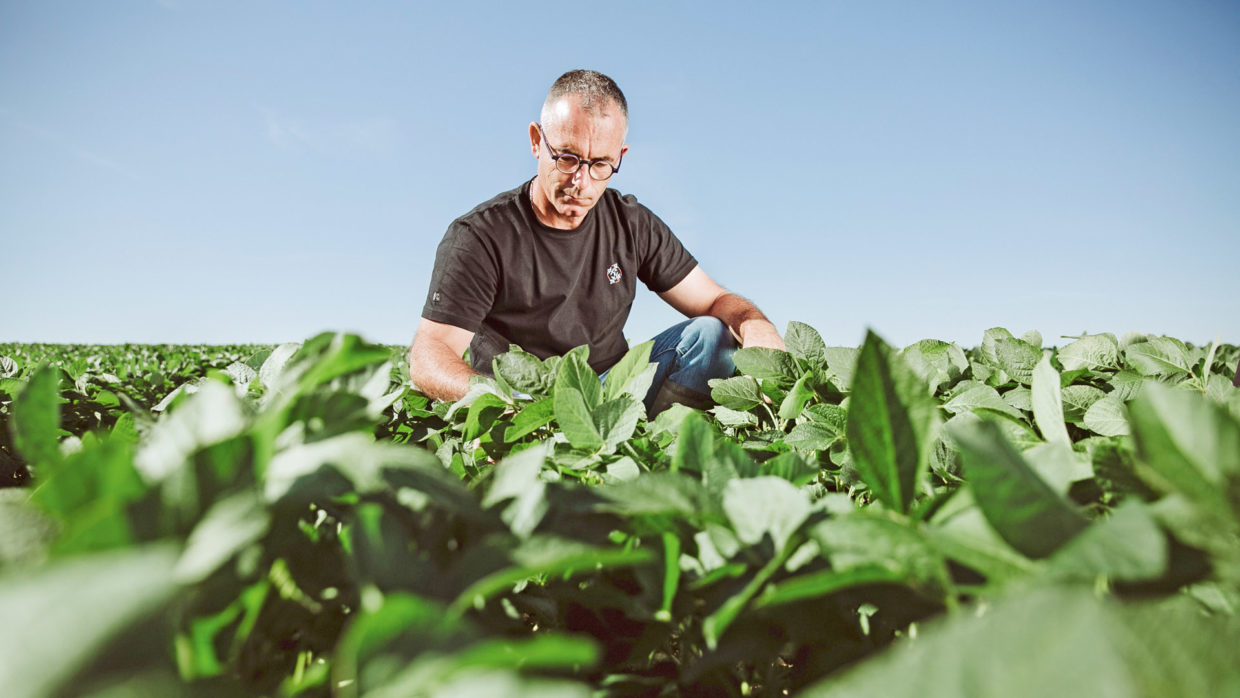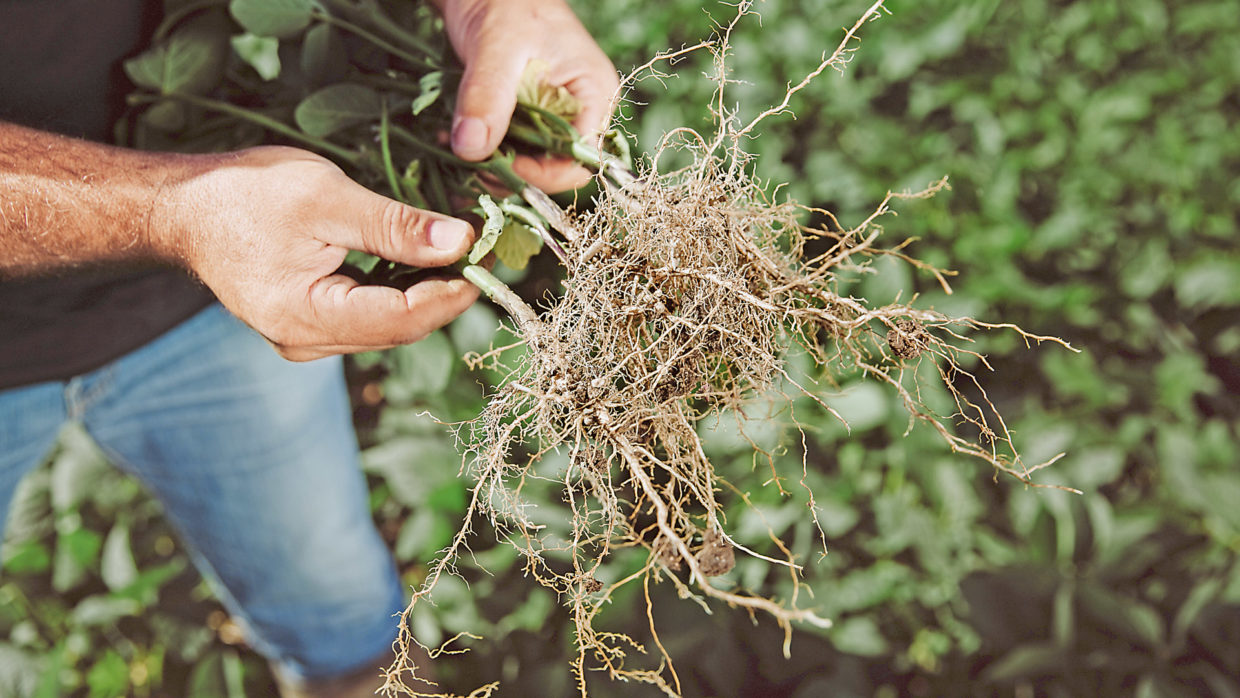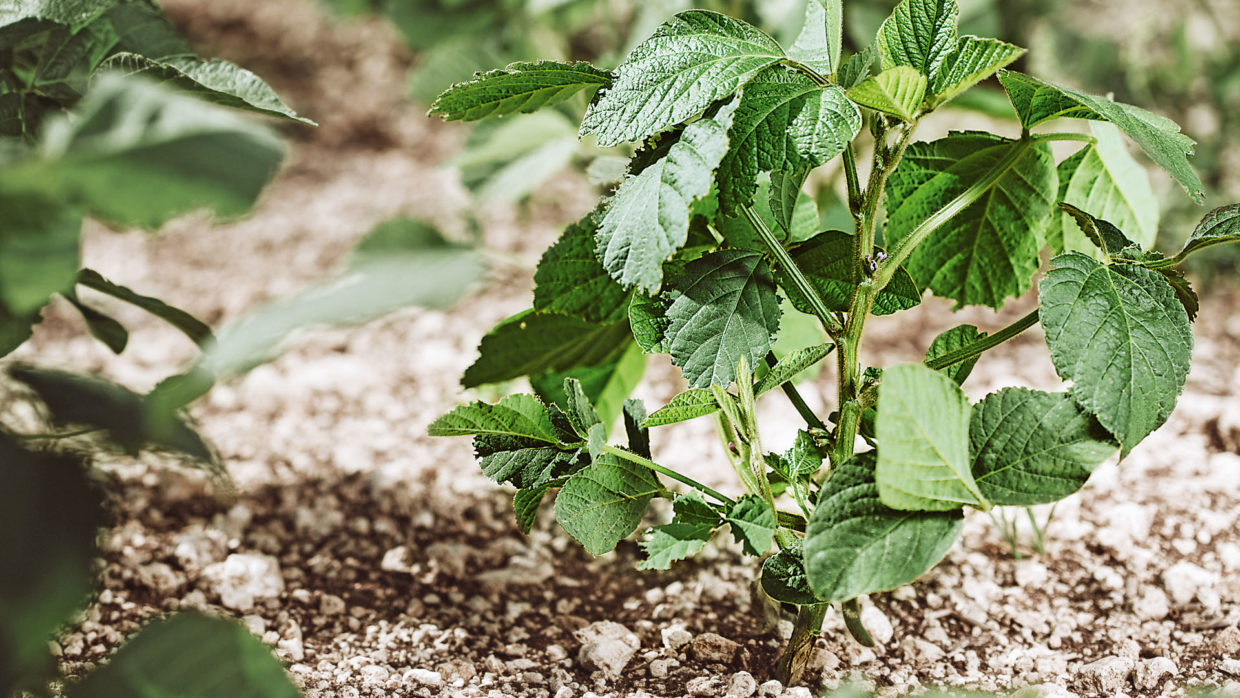Suèvres, Loir-et-Cher: The crops alternate in a gently undulating landscape, punctuated with hedges which protect the fauna. Jean-Michel Ombredane stands under a bright sun in the middle of his soyabean field. He shows the roots of a freshly dug up plant and the rhizobium nodules which cling to it. “Soyabeans integrate well into rotations,” he says. Not far from there, garden peas are also standing tall. Mr Ombredane, president of the departmental union of seed growers, SAMS (Syndicat Départemental des Multiplicateurs de Semences), cultivates 15ha of soyabeans in a conventional system on a seed contract, along with other leguminous crops.
The French soyabean sector is still taking its first steps, producing 420,000t in 2018. Beyond the ecological interest, the challenge is to reduce the 45% deficit in protein-rich feed for the livestock sector. Some 3.5m tonnes of soyabean meal is imported annually into France. This is a commendable degree of independence compared to the whole of Europe, where protein imports cover 70% of the needs. This well-known European protein deficit has been around for at least 50 years, but the issue has become more political in recent years. Still, the situation will only improve if it makes economic sense for farmers to produce their own protein.
Soy cultivation comparable to beans
Mr Ombredane has run the 350ha farm over three locations since 1994, together with his parents and his brothers François and Damien. Seed growing takes about 30% of the cultivated land, with a dozen species, including peas, onions, spinach, radishes and sugar beet, as well as wheat and barley, providing varied crop rotations.
“The cultivation of soyabeans is similar to that of beans, but with some extra precautions,” says the farmer, who is passionate when it comes to his crops. Firstly, with the inoculated seeds, you need to make sure that the rhizobia are well conserved. This year, the farmer used a seed drill with a row spacing three times wider than for small grain seeds. As for weed control: “It is more effective looking at the weeds’ stage of development than the soyabean stage.”
Soyabeans integrate well into rotations, but there is a downside: Care is needed with field beans, as both species are sensitive to sclerotinia. So leave at least four years between crops, so as not to increase the inoculum. “On the other hand, there are no other diseases, and there are fewer pests,” says Mr Ombredane. Here, at the border of the Loire Valley and the Beauce, soils vary. The rendzinas are on slight slopes of limestone: The bedrock is at 30cm, without capillary rise of water. The organic matter contents range from 2.5 to 3.5% and the pH figure can rise to 8. The water retention capacity is low. Fortunately, all plots can be irrigated, a necessity for sweetcorn and soyabeans.
Cautious optimism about the protein gap
“Soyabeans need water, but less than maize,” says Mr Ombredane. With this year’s drought, he irrigated his fields twice by mid July with 30mm each time. Should the lack of rain continue, he would need to repeat this another five to six times. Usually, harvest takes place in September and the seeds are quite robust. Year-on-year, yields range from 3-4t/ha and the price for seed can be €100/t (£90/t) higher than that of imported soyabeans.
Soyabeans integrate well into rotations.
Jean-Michel Ombredane
When it comes to increasing the soyabean area and reducing the protein gap in Europe, Mr Ombredane is cautiously optimistic: “The political will has been shown, but the economic conditions may have difficulty keeping up. In France, costs and charges are very high, and standards and obligations are very strict.” And there are still the market conditions: The feed industry is structured for using imported soya, and restructuring the sector is complex. But the competency of farmers to produce high-end non-GM soyabeans is in place, points out Mr Ombredane. “Technically, we are up to speed.” Increasing the acreage will be done little by little; the ambition of stakeholders in the French soyabean sector is to increase production to 650,000t in 2025.
Maintenance breeding
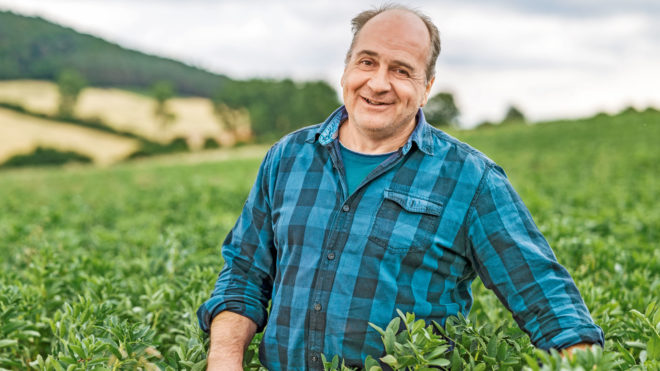
German farmer Uwe Brede produces seed and feed crops in a no-till system. In addition to cereals (winter wheat, spring and winter barley, winter triticale, winter rye, and oats), he grows various legumes including peas, red clover and field beans.
With 2.6m tonnes of soyabeans produced in Europe each year, the industry is still far from meeting livestock producers’ concentrated protein requirements – unless they bet on future progress in breeding. “Reducing this deficit is possible thanks to alternative solutions,” says Uwe Brede, an organic egg producer in the state of Hessen, Germany.
On the 180ha Niederbeisheim estate, protein autonomy has been a guiding principle since the early 2000s. “The quantity (of home-produced protein) is very limited in Germany,” says Mr Brede. The farm feeds 10,500 laying hens and 18,000 Lohmann Brown pullets.
A two-minute walk from the farm buildings, a large plot of broad beans stretches out. “We have specialised in this practice,” says Mr Brede, who is growing 20ha of broad beans in 2019. This is the Bilbo variety, which the farmer produces for his ration and conservation purposes. “It has purple flowers and a long stem, a useful trait against weeds. It has a very homogeneous maturity, which is also important for us. The protein content, at 27%, is good, and the yield is between 4 and 6t/ha.”
Laying performance
The variety performs well despite the modest soil quality and high altitude of the farm. Thanks to an advantageous amino acid profile, and because the hens do not eat the shell – which contains tannins – the seeds contribute to the protein autonomy of the farm without penalising the hens’ laying performance (about 270 eggs per hen a year). The beans comprise 12% of the feed ration.
Laying hens have high requirements for protein-rich feed and Mr Brede must rely on other sources too: Hemp cake, peanuts, safflower, flaxseed, pumpkin seeds or hazelnuts, depending on availability, for a further quarter of the ration. “These oleic co-products allow me to provide other types of amino acids.” In 2019, he cut the share of soyabeans in the ration to 5% – buying his soyabeans directly from German or European farmers. Cereals (wheat and barley) account for 37% of the ration, plus sunflower and rapeseed cake (4% respectively), as well as minerals and other supplements.
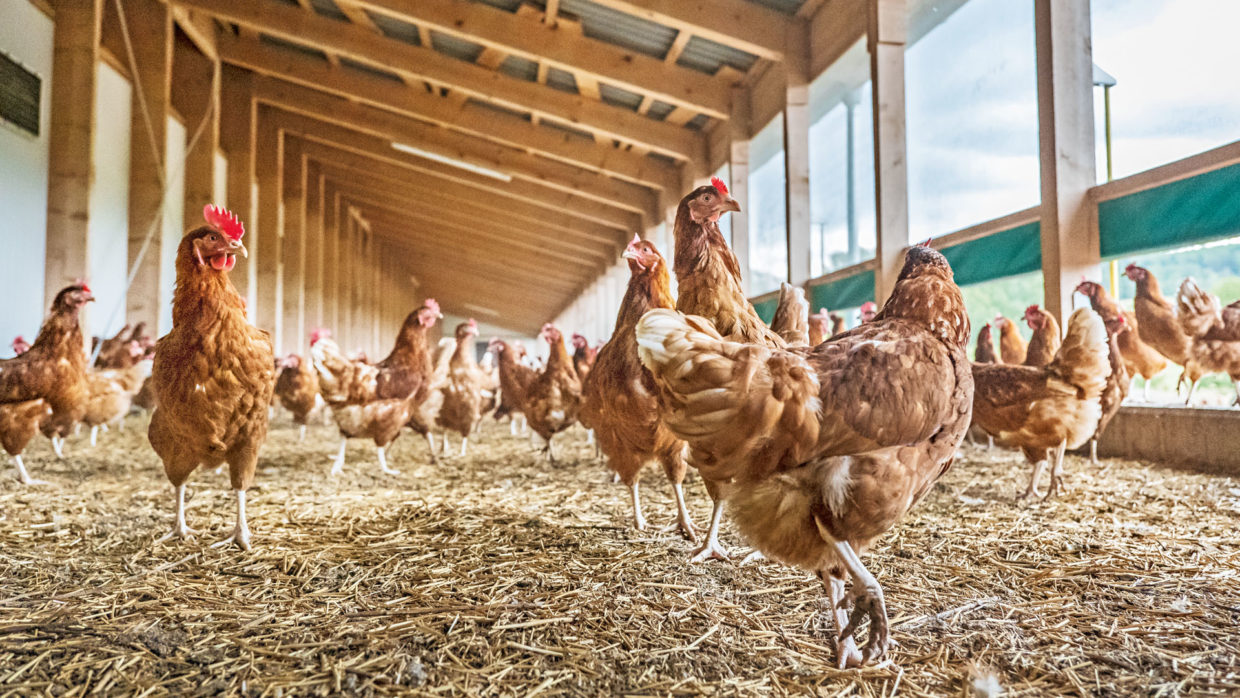
The feed requirement is around 550t per year and the farm owns 28 silos, used to produce its own organic compound feed.
Reducing the deficit
Such a system comes at a cost. Mr Brede optimises his margins by selling direct to regional supermarkets. With a neighbour, he has just invested €230,000 (£207,500) in an egg packing machine. And they can only reach their goal of protein autonomy thanks to clientele who are willing to pay more for a sustainable label. All things considered, he reckons it is possible that organic livestock farming in Germany could achieve independence from protein imports.
But when it comes to conventional production, talking about autonomy is illusory in the short term. “That said, we could significantly reduce the deficit. It would require a lot more resources for research and breeding, and work to optimise seed treatment, for example by applying the methods used for soyabeans.”
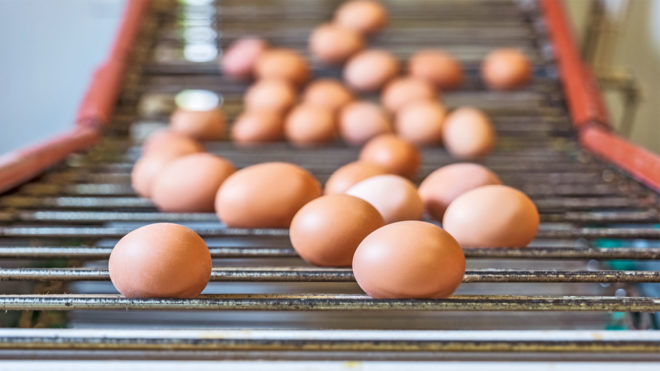
Two-thirds of the Niederbeisheim estate’s turnover is generated by livestock production, comprising egg sales to regional supermarkets under its own brand and the sale of 17-week-old Lohmann Brown pullets to other farms.
Protein demand, a key factor
The real change, according to Mr Brede, should come from the retail sector. “We create supply; demand needs to be raised. It would be great to see an advertising campaign touting a ‘sausage made from (pigs fed with) local plant proteins’. If one chain went ahead with it, the others would follow. Of course, committing to a guarantee of origin is an obstacle for large retailers.”
Idealistic as it may be, this solution would be more sustainable in his eyes than financing greening through subsidies. “Leguminous crops would be more profitable in arable farming, and it would be economic security for livestock farms.”
We create supply; demand needs to be raised.
Uwe Brede
Still, communicating the issue is not easy. “Outdoor farming is easy to promote, people see that the animals have space. But in the context of imported soyabeans, nitrates, nitrogen fixation, animal production… it is very complex for the consumer.” Mr Brede therefore wants to inform and educate. A leaflet devoted to the issue is placed in each box of eggs sold, and the farm website is being updated accordingly. There will also be an open day to celebrate the farm’s 25th anniversary this year, to which he expects 2,000 visitors.
“Starting from eggs, my ambition is to provide an overview of the problem, going through the production of farm food, and up to a visit to the breeding plots. I hope to make it clear for visitors to see the link between plant proteins and those of animals.”



